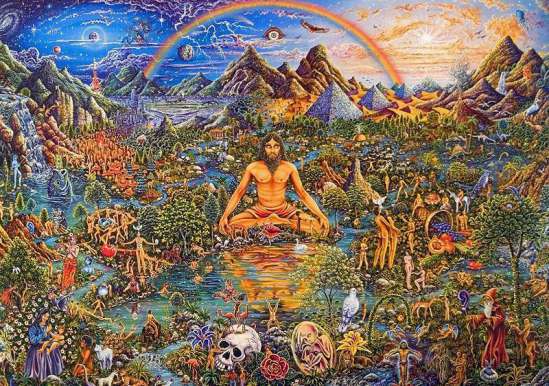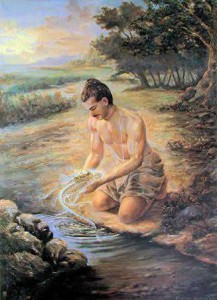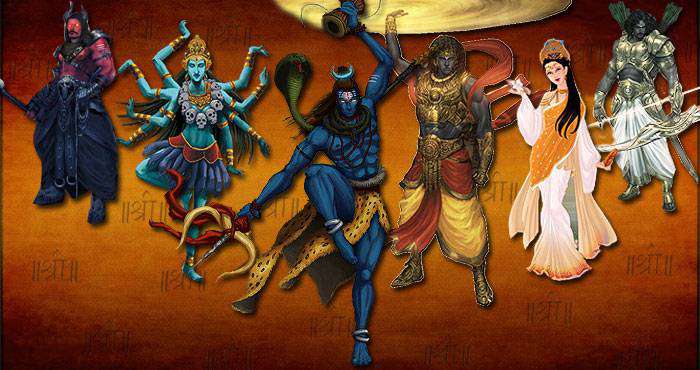No products in the cart.
We have been carefully taught to understand, respect and inculcate the values and traditions that were passed down to us from our ancestors. And we preserve our many simple memories of such instances in our little albums and huge tapes. Similarly, there is another appealing up scaled story. A story of Indian history, where the traditions have been passed down to us from as early as the first century BC through an album of the rise and fall of many events. Most of which were lost physically in the clocks of sand, while some managed to be preserved neatly and are still evident as delicate remnants. But all of them are artfully saved in the invisible memory sticks of the ancient chronicles, our intellectual treasures that we continue to pass on as alluring myths.
Let us flip through these archives, all the way back to the first chapter. By archives I refer here to the first written form of Vedas, the Rig Veda and by first chapter I intend to highlight the earliest cosmology beliefs to understand the timeline that follows.
“At first was neither Being nor Non-being. There was not air nor yet sky beyond. What was its wrapping? Where? In whose protection? Was water there, unfathomable and deep?
There was no death then, nor yet deathlessness; of night or day there was not any sign.
The One breathed without breath, by its own impulse. Other then that was nothing else at all.
Darkness was there, all wrapped around in darkness. And all was water indiscriminate. Then that which was hidden by the Void, that one, emerging, stirring, through power of Ardor, came to be.
In the beginning Love arose, which was the primal germ cell of the mind. The Seers, searching in their hearts with wisdom, discovered the connection of Beings with Nonbeing.
A crosswire line cut being from Nonbeing. What was described above it, what below? Bearer of seed there were and mighty forces, thrust from below and forward move above.
Who really knows? Who can presume to tell it? Whence was it born? Whence issued this creation? Even the Gods came after its emergence. Then who can tell from whence it came to be?
That out of which creation has arisen, whether it held it firm or it did not, he who surveys it in the highest heaven, he surely knows – or maybe He does not!” – Rig Veda X, 129
This is a leaf of the Nasadiya Sukta, which lingers beyond the natural boundaries of religion to comprehend existence of the world which later was incorporated into the Brihadaranyaka Upanishad with additional clarifications and explored ideas by Yagnavalkya, who describes Universe in the following terms:
Everything on earth is wrapped in water. Water is wrapped in air. Air is wrapped in sky. Sky is wrapped in the world of Gandharvas (planets?). World of Gandharvas is wrapped in Aditya (Sun). The world of Sun is wrapped in the world of Chandra (Moon). The world of Moon is wrapped in the world of Nakshatra. The world of Nakshatra is wrapped in the world of Deva’s. The world of Deva’s is enclosed in the world of Indra. The world of Indra is wrapped in the world of Prajapati. The world of Prajapati is wrapped in the world of Brahmana.
Simply the whole universe is distinguished in two halves, the upper or Deva loka and the lower or the Bhuva loka and the space between them is the sky or akaasha.
They eventually manifested as the Sapta Lokas, Sapta Patalaas, Dasha Dishas, Sapta Dwipas, Sapta Samudras and Sapta Parvatas. You can only possibly look them up on a globe of the universe or for now, on Google.
And to foresee this creation were intended the eight rulers of the world or the Ashta Lokapalas Indra, Agni, Yama, Nirruti, Varuna, Vayu, Kubera and Ishana; and the clock was set in a more marveling fashion beyond comprehension.
“The minuscule fragment of time being a Triti, hundred tritis is one Vedha, three Vedhas are one Lava, Three Lavas are one Nimesha, Three Nimeshas are one Kshana, five Nimeshas are one kashta or eight seconds, fifteen kashtas are one laghu or two minutes, fifteen laghus are one danda, six to seven dandas are one fourth of a day or night, four praharas or yamas are one day or night, two pakshas form a month, two months form a Ritu or Season; Six months form one Ayana, 365 combinations of a day and night are one a Deva year which is equal to 1200 Yugas which are further classified as Satya Yuga of 4800 Deva Years, Treta Yuga of 3600, Dwapara of 2400 and Kalki Yuga of 1200 Deva Years which together make one a Maha Yuga; a 100 Maha Yugas form one Kalpa and Two Maha Kalpas are one life time of Brahma.”

Tracing back to our present interest, Gandharvas or the planets are the first mention of earth and the living beings. Daksha Prajapati is referred to as the father of all living beings on the seven different worlds. Prajapati and his wife Prasuti had sixty daughters, ten of whom were given in charity to Dharma, seventeen to Kashaypa Muni, twenty seven to Chandra and two each to Rishis Angirasa, Krasaswa and Bhuta and thus preceded all life forms including the Devas, Daityas, Danavas, Nagas, Rakshasas, Apsaras, Gandharvas and also wild life, rivers and creepers.
“Dharma’s wives gave birth among others to Twelve Sadhyas called Jaya Devas considered as good as Devas. Dharma’s another wife Vasu gave birth to Ashta Vasus like Dhara, Soma, Ayu, Pratyusa etc. From Angirasa and Vastu Devi was born Vishwakarma.
But the most significant progeny of Daksha’s daughters was from Kashyapa Muni as, Indras and Devas from Aditi while Diti gave birth to Daityas like HiranyaKashipu and as also Marudganas;
Danu Devi gave birth to Danavas whose Chief was Viprachit and the latter’s wife Simhika gave birth to Simhikas who were considered more cruel and notorious than Danavas. Rahu, the eldest son of Simhika is the most infamous. The worst of Danavas were Shambhara, Maya, Tarakasura, Jambha, Naraka and Pralamba.
Devi Kadru another wife of Kashyapa Muni was the mother of Serpents, the most being Sesha, Vasuki and Takshaka besides Iravata, Mahapadma, Kambala, Ashwatara, Shankha, Karkotaka, Dhananjaya, Kaliya and so on.
Khasa Devi had two sons one at dawn time and another at dusk. The elder son had four hands and four legs and the younger one had three heads, three hands and three legs. Both were ferocious and grotesque; one wanted to eat his mother out of extreme hunger and another desired to save the mother. Kashyapa named them Rakshasas; they were weak and dull but as the dusk grew into night they became invincible and all powerful with the ability to change into any form enjoyed eating flesh.
Surabhi was the mother of cows and buffalos.Vinata was the mother of Garuda and Aruna, the charioteers of Vishnu and Surya. Arista gave birth to Gandharvas. Muni was the mother of Aprasas or Angels. Ila Devi was the mother of creepers. Tamra gave birth to vultures, eagles and raven, Timi to aquatics and Saras to tigers, lions and ferocious animals.”
– Brahma Purana
Thus Kashyapa Vamsha stood for Dharma, Kshama and Virtue. Aslo at the same time represented adharma, jealousy, cruelty and sheer depravity.
But the most notable and relatable context of Puranas are the fourteen Manus- Swayambhu, Swarochisha, Uttama, Tamasa, Raivata, Chakshusa, Vaivaswata, Savarni, Bhoutya, Rouchya and four more Savarnyas, each with a story of their Vamshas as fascinating as the next.

Manu is the name of the first human to appear in the world in an era, after the universal destruction giving way to the next cycle. According to the Puranas fourteen Manus appear in each Kalpa and the period of each Manu is called a Manava avtara. The present is the world of, the seventh Manu also known as Sraddhadeva or Satyavrata, who was the King of Dravida before the great flood. He was warned of the flood by the Matsya avatar of Vishnu and built a boat that carried his family and the seven sages to safety by the Matsya. Vaivasvata is depicted as the Biblical Noah similar to the story of the Ark. The lifespan of a Manu is 71 Maha yugas and the present Manu has already lived for 28 Maha yugas. Mandhata from the Ikshvaku lineage of Vaivasvata Manu followed by Kakustha, Yuvanashra and Muchukunda during whose reign took place the epic saga of Bhagavata, is said to have discovered the Manas Sarovar and subsequently the Asian Subcontinent and ruled over Bharata.
“Mandhata, the undisputed Emperor of the World comprising Seven Dwipas ‘from where Sun rose at where it was set!’ He was stated to have discovered Manasa Sarovar on Mount Kailas, when he was reputed to have performed Tapas at the banks of the Lake. It was believed that there was a Serpent Mansion where the Emperor prayed under a Jamun Tree from which its fruits dropped into the Sarovar making the sound of ‘Jam’ and the area underneath the Sarovar was called Jambu Dwipa!”
Similar mentions have found place in most modern literature,
“Manu is the prince from south India, whose family the Pandyas have ruled the mythical land of Sangamatamil for many generations. The decadence of the kings incurred the wrath of the gods. A great deluge submerged the entire civilization. Manu having foreseen this escaped with his followers to the higher northern lands. Manu turned into an ascetic. Eventually Manu’s prayers pacified the gods and the water abated.” -Immortals of Meluha.
Long story short, the whole universe is considered to be a fragment of imagination of the supreme creator or Brahma, to unfurl through a sea of illusions the great awareness or Mahatatva marking Ahamkara or ego, as an abstract form of inherent consciousness. This literally translates to the creation of the world being but an opportunity of all eternal beings to realize the truth of a simple cycle of life. Every human incarnation has been to restore this cosmic order of true awareness and the inherent ego.
And so, our ancient banks of wisdom have been teaching us that the only path to this spiritual realization is that of love, explaining the cosmic laws through mythologies and making way for newer myths through the cosmic cycles.






